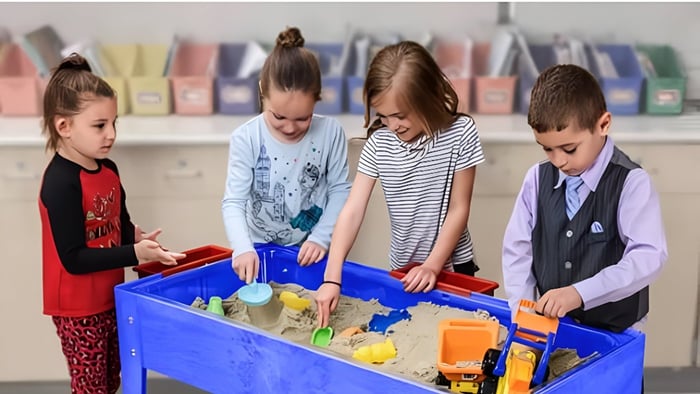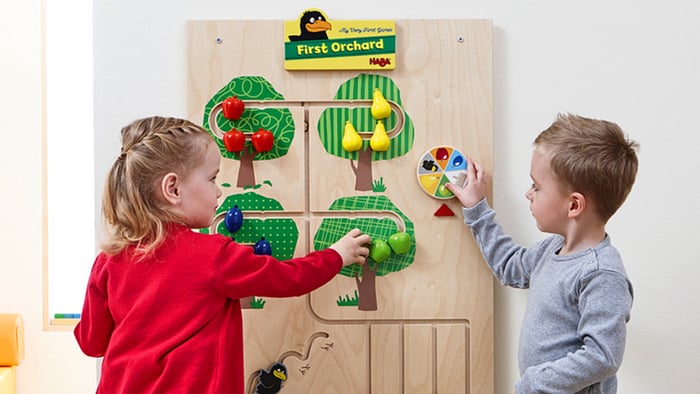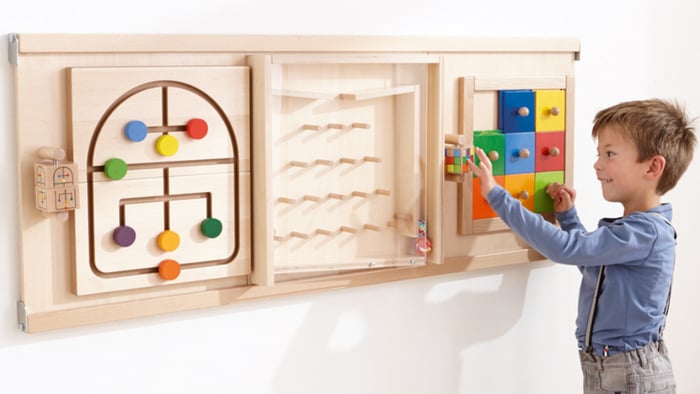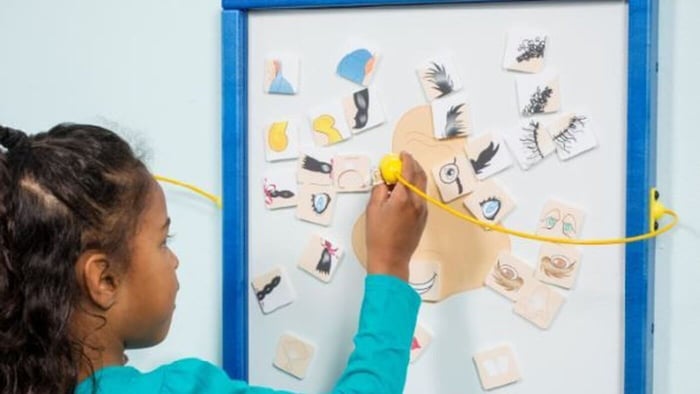
The Benefits of Sand and Water Tables for Children's Development
Table of Contents
Sand and water tables have long been a staple in early childhood classrooms, play centers, and home learning environments—and for good reason. These versatile sensory tables offer far more than just entertainment. They provide young children with a rich, multi-sensory play experience that supports cognitive, physical, emotional, and social development in powerful, lasting ways.
Whether placed in a preschool classroom, daycare playground, therapy room, or even a backyard, sand and water tables encourage hands-on exploration, imaginative thinking, and meaningful learning. Let’s take a closer look at how these simple play stations support early childhood development.
Youth Double Mite Sand & Water Table

$391.74
The Youth Double Mite Sand & Water Table, manufactured by the renowned brand Childbrite, is a must-have addition to any sensory, sand & water tables...… read more
🖐️ 1. Sensory Development: Engaging the Senses Through Play
At the heart of every sand and water table is sensory exploration. When children scoop, pour, squish, and sift through sand or splash and swirl water, they are engaging multiple senses at once—especially touch, sight, and sometimes sound.
This type of multi-sensory play promotes:
- Tactile awareness – helping children understand different textures (e.g., dry sand vs. wet sand)
- Visual tracking – watching water pour or sand funnel down spouts
- Auditory stimulation – hearing water splashing or sand shifting
- Sensory regulation – calming overstimulated children through rhythmic, repetitive play
Sensory play is particularly beneficial for children with sensory processing challenges, including those on the autism spectrum, as it offers a safe and engaging way to process stimuli in a structured environment.
✋ 2. Fine and Gross Motor Skill Development
As children dig, scoop, pour, funnel, and manipulate sand or water tools, they are building fine motor strength and hand-eye coordination. These skills are foundational for later tasks like writing, cutting, buttoning clothes, and tying shoes.
Even lifting and carrying heavier buckets or navigating around the table supports gross motor development by strengthening arms, shoulders, and core muscles. These movements are often disguised as play—but they are laying the groundwork for physical independence.
🧠 3. Cognitive Development and Problem Solving
Sand and water tables invite children to experiment, explore, and discover—which are critical aspects of early cognitive development.
By playing with various tools and materials (such as cups, scoops, sponges, funnels, and toys), children naturally learn about:
- Cause and effect: “What happens when I pour water from a high spot vs. low?”
- Spatial awareness: “Will this amount of sand fit into that container?”
- Prediction and observation: “If I squeeze this sponge, will water come out?”
- Early physics: “Why does this float while that sinks?”
This self-directed discovery process encourages critical thinking and builds early foundations for STEM (science, technology, engineering, and math) education—without the need for formal instruction.
Neptune Sand & Water Table - 24"h

$292.09
The Neptune Sand & Water Table - 24h is a versatile and engaging outdoor sensory table perfect for children's playtime. This sturdy table provides a...… read more
🎨 4. Open-Ended Play and Creativity
One of the greatest strengths of sand and water tables is their open-ended nature. There is no right or wrong way to play, which gives children the freedom to experiment, pretend, and express themselves in unique ways.
Children might:
- Build imaginary kingdoms with sand towers and moats
- Pretend to cook “soup” with water, leaves, and cups
- Create ocean scenes with toy animals and shells
- Dig for treasure or fossils using scoops and sifters
- Invent water delivery systems with funnels and tubing
This imaginative, narrative-rich play supports creativity, language development, and emotional expression—especially when paired with theme-based learning or storytelling.
🤝 5. Social Development and Cooperative Play
When multiple children gather around a sand or water table, they learn essential social skills that help them navigate relationships and group dynamics.
These include:
- Taking turns and sharing tools
- Negotiating roles and play scenarios
- Collaborating on builds or clean-up
- Respecting personal space and materials
Teachers and caregivers can facilitate group projects and conversations, using the table as a platform for building community and social-emotional intelligence.
🔬 6. STEM Learning in Action
Sand and water tables are perfect natural laboratories for introducing STEM concepts in age-appropriate ways. Through guided or independent play, children begin to explore:
- Measurement: Using cups, scoops, and graduated containers
- Volume and capacity: Understanding full, empty, and in-between
- Physics: Observing gravity, flow, and resistance
- Engineering: Building bridges, dams, or funnels with sand or water
- Scientific inquiry: Formulating questions, making predictions, and drawing conclusions
Educators can easily extend learning with open-ended questions like, “Why do you think this object floats?” or “How can you move the water from here to there without spilling it?”
😌 7. Emotional Regulation and Mindfulness
The calming, repetitive nature of sand and water play can be incredibly grounding for young children. For kids experiencing stress, overstimulation, or emotional dysregulation, this type of play provides a soothing, sensory outlet.
By scooping, swirling, pouring, and exploring at their own pace, children develop:
- Focus and sustained attention
- Self-regulation and impulse control
- A sense of accomplishment and independence
These experiences are not only beneficial for individual growth but also support classroom harmony and a more peaceful learning environment.
See All Children's Sand & Water Center

$364.67
The See All Children's Sand & Water Center by Childbrite is a remarkable addition to the Sensory, Sand & Water Tables category. Designed with children...… read more
🌟 Adaptable for All Ages and Abilities
Sand and water tables are highly inclusive and can be adapted for different developmental levels:
- For infants and toddlers, tables can be lowered and filled with safe sensory materials like water beads, shredded paper, or bubbles.
- For preschoolers, tools and props can add complexity to spark deeper exploration.
- For children with special needs, teachers can use these tables to support OT goals and offer calming sensory input in structured ways.
- For older children, curriculum-based experiments and challenges can be incorporated to introduce more advanced concepts.
With the right modifications, sand and water play is beneficial—and enjoyable—for all.
🛒 Shop High-Quality Sand and Water Tables at Little People’s Cove
At Little People’s Cove, we understand that the best learning happens through play. That’s why we offer a curated selection of sand and water tables and sensory play accessories that are:
- 🌦️ Durable and weather-resistant for indoor or outdoor use
- 🧼 Easy to clean with drain plugs, lids, and non-porous materials
- 🌱 Eco-conscious and safe, made with child-friendly materials
- 🎒 Designed for classrooms, daycares, and homes
From compact tables for individual play to large group tables for collaborative exploration, we have something to fit every age, space, and learning style.
🌈 Let the Learning Flow
Sand and water tables are much more than toys—they’re tools that open the door to exploration, creativity, growth, and connection. Whether your goal is to support sensory development, foster social skills, introduce STEM concepts, or simply bring joy to your classroom or backyard, these tables deliver endless opportunities for learning through play.
✨ Ready to enhance your space with purposeful play?
Start your sensory sand and water journey today at Little People’s Cove—and give your children the gift of curiosity, discovery, and development, one scoop at a time.



